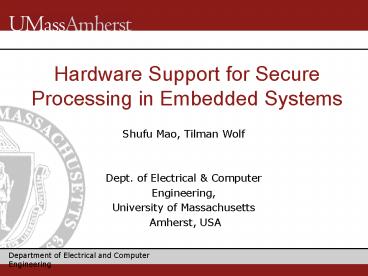Hardware Support for Secure Processing in Embedded Systems - PowerPoint PPT Presentation
1 / 13
Title:
Hardware Support for Secure Processing in Embedded Systems
Description:
Shufu Mao, Tilman Wolf. Dept. of Electrical & Computer. Engineering, University of Massachusetts ... Suh et al.: tracking of information flow in system ... – PowerPoint PPT presentation
Number of Views:115
Avg rating:3.0/5.0
Title: Hardware Support for Secure Processing in Embedded Systems
1
Hardware Support for Secure Processing in
Embedded Systems
- Shufu Mao, Tilman Wolf
- Dept. of Electrical Computer
- Engineering,
- University of Massachusetts
- Amherst, USA
2
Embedded System Security
- Unique vulnerabilities in embedded systems
- Require specialized solutions
- Representative embedded system
- System-on-a-chip uniprocessor
- Simple processor core without complex operating
system - Potential attack goals
- Extraction of secret information
- Modification of stored and sensed data
- Denial of service attacks
- Hijacking of hardware platform
- Damaging or destruction of device
- In many cases attack can be observed
- Deviation from programmed system behavior
3
Outline
- Embedded System Security Overview
- Related Work
- Monitors Architecture
- Monitor Graph
- Monitor Ambiguity and Overhead
- Evaluation with Real Attacks
- Static Attacks
- Dynamic Attacks
- Summary and Conclusions
4
Monitor Architecture
- Offline binary analysis
- Monitoring graph extraction
- Online validation of processing
- Information stream from processor
- Comparison to monitoring graph
- Requires call stack for returns
- Interrupt/recovery on deviation
- Choices on what to monitor
- Address
- Vulnerable to code replacement
- Opcode
- Vulnerable to changes in registers
- Control flow
- Vulnerable to code replacement within basic block
5
Monitoring Graph Example
- Example
- MiBench on SimpleScalar simulatior
- Monitoring graph
- Chained basic blocks
- Different information within basic blocks
6
Monitoring Ambiguity
- Ambiguity in monitoring
- Conditional branch
- 1000 instructions from patricia application
- Address monitor
- Only two possible statesafter conditional branch
- Opcode monitor
- Large ambiguity for similar instructions
- Control flow monitor
- Large ambiguity on recursive function calls
7
Monitoring Ambiguity and Overhead
- Cdf of ambiguity duration
- Other MiBench applications
- Cdf shape varies widely with application
- Average ambiguity duration less than 2
instructions - Monitoring overhead
- Other MiBench applications
- Roughly 10 of binary
8
Evaluation with Real Attacks
- System Attacks
- Static Attacks change the binary file
- Dynamic Attacks change the run-time program
behavior
9
Performance of Monitor Static Attack
- Static Attacks - Bit Flip Attack
- Choose one application (gsm) from Mibench
- Random picks one instruction and change one bit
- Results based on 100 simulations
10
Performance of Monitor Dynamic Attack
- Dynamic Attacks
- One program with buffer overflow attack
int count, address, ptr void funct(void)
count0 //to avoid an empty function void
fill_buffer() int buffer10 ptr
buffer for (count 0 countlt20 count)
ptraddress ptr int main
(void) address (int) funct
fill_buffer()
11
Performance of Monitor Dynamic Attack
12
Related Work
- Embedded system attacks
- Proximity attacks (tampering, side-channel,
FPGAs) - Remote attacks (mobile phones, sensor nets)
- Processing monitor
- Zhang et al. invariants on kernel data
structures - Arora et al. similar monitor, but basic block
hash - Suh et al. tracking of information flow in
system - Abadi et al. control flow integrity with
modified binaries - Other monitors
- Zhuang et al. bus monitor to avoid data leakage
- Chi et al. thermal sensor for performance
improvement - Velusamy et al. thermal sensors on FPGA
13
Summary and Conclusions
- Monitoring can be used to detect deviation from
normal system behavior - Different patterns are evaluated
- Address pattern
- Opcode pattern
- Load/Store pattern
- Control flow pattern
- Hashed pattern
- Future work
- Different monitor types
- Suitable recovery actions
- Attack benchmark






























